#and! he pulled a hideo kojima reference!
Explore tagged Tumblr posts
Text
So. Argenti demo.

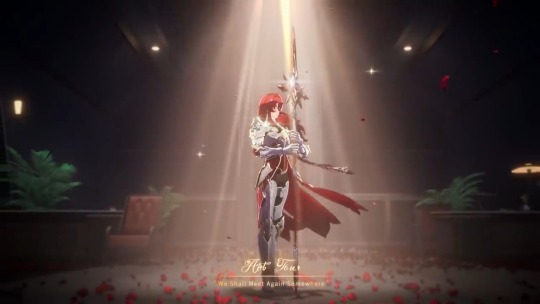

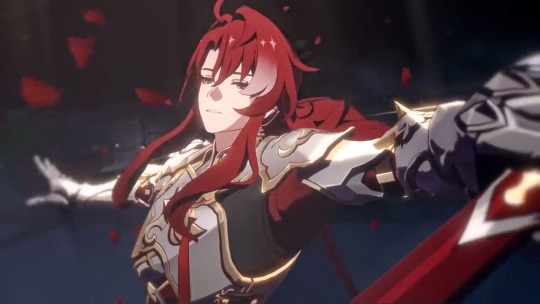

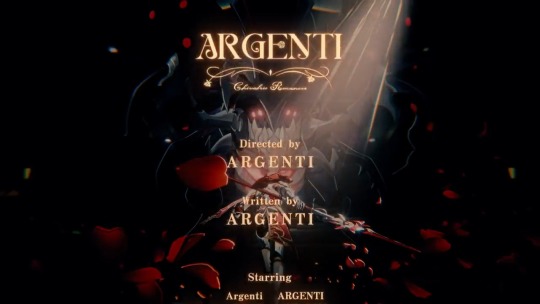
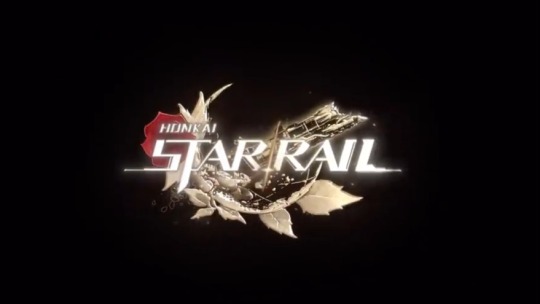
#he's everything to me you have no idea#silly goofball of a theatre kid ily ily ily#his demo splash is soooo pretty#his animations are gorgeous#his personality is perfect#and! he pulled a hideo kojima reference!#also bonus points for every member of the express getting to do the last line in the demo#across the 4 languages#brilliant#beautiful even#this is argenti's train and we're just riding it with him#honkai star rail#hsr#hsr argenti#argenti hsr#pink's musings#pink thinks about sir flowerboi for more than two minutes and explodes
29 notes
·
View notes
Text
Okay, because I suck at video games and didn’t have much for systems when I grew up I didn’t really play Metal Gear or know a lot about Hideo Kojima or his writing style, and I will admit. Could stand to interact with and learn to write more women, but he is steadily improving at that I think, and it’s not like it’s a Kojima exclusive problem when it comes to Video Games and Writing Women Characters. He actually writes women with stories, it’s just that his stories are fucking batshit so every now and then you sit there and go “yo wait hold on what the fuck???”
But from what I’m getting, listening to various explanations of the lore and stuff of his games (especially, currently, Death Stranding because I’ll be honest that game’s opening was dope as hell but I did struggle to stay engaged because my ADHD and inability to actually play games meant I was watching other people and that removed a lot of the engagement. I just cannot focus on something long enough to make the experience worthwhile.) is that a lot of his stuff feels like when you’re playing pretend with your friends as a kid, but then also applying the ability to create storytelling and literary devices like an adult who went to University.
Which is very very fun. Maybe literary is the wrong word, it’s more cinematic, but the lore choices and stuff is like. “Is that a biblical reference?” Along with some guy named “Die Hard Man” because he kept surviving things during the war, which tbh if I know nicknames correctly that guy would have gotten a nickname like “Roach” for that. You don’t get cool nicknames from your friends in the military, you get dumb nicknames. Even if Die Hard Man sounds dumb, I think it’s supposed to be cool. I think most military nicknames are insults. Honestly in general most nicknames are insults.
But Kojima works under the same mindset as I did when I in elementary school and played games with the other neighbourhood kids and said I was “Wolf because I was raised by wolves” because that was the level of creativity we were working with because I was fucking 7 and we were basically just riding our bikes in the cul-de-sac or however that’s supposed to be spelled and not actually knowing how anything worked. Because being a child in the 90s that’s kind of a normal activity?
I feel like that’s what Metal Gear Solid feels like, and Snake is just the vibe of “a cool animal name that can be a military hero.” Hell isn’t there a character in the first Metal Gear Solid that was actually raised by wolves? Like just, exploring concepts we all definitely thought were cool at one point or another and then finding ways to either play them straight or pull a full plot out of it, while also just going kinda batshit. I can appreciate that.
I think he needs to maybe meet some ladies that he finds as inspiring as the dudes he definitely maybe has huge fucking muse crushes on because I feel like that might be part of the problem, Norman Reedus and Mads Mikkelsen and Guillermo de Toro have obviously like really inspired him as people, but like. Maybe the memes haven’t been as obvious about the women in his life, but that might also be why the female characters in his games sometimes fall flat? Though I have heard fantastic things about The Boss, and Bridget in Death Stranding is. Definitely notable and interesting and I think she’s supposed to be a complex villain? I think that’s a normal set of feelings to have for her?
Like he’s a Japanese director, wordplay is huge in Japan, and most Japanese names have meaning, especially in media. Those names are picked for a reason. Yeah Kojima definitely picks hammy names but they stand out in part because they’re in English. But he made military and post apocalyptic games with surreal and slightly silly tones despite serious topics, and naming conventions like this aren’t uncommon in Japanese media. They’re just extra hammy in English. And double extra hammy because Kojima is eccentric. But I feel like that eccentricity is necessary to keep games from becoming… the most boring grimy shit you will ever experience. I need inspiration and fun, and Kojima seems to inspire the whole industry to have more fun, and also wants everyone else to play. Which is why he has so many collaborators?
And he designs games to have teams working on them and with the idea in mind that the people working for him should always have work in the future, that was part of the Fox Engine and PT gambits? To keep his team employed in the future, not just himself?
This has been a very long rambling nothing, but while he costs a lot of money to create things, I think he also is like… actually interested in just… “let’s see what this baby can do, shall we?”
And I think we really fuckin need that in video games. Like damn. Yeah. Go ham dude. Figure it out, fuck Konami. Let’s play some games and get wild or something. Be weird.
1 note
·
View note
Text
Death Stranding and The Last Man on the Beach
I had a very personal connection with Hideo Kojima's Death Stranding last year. I liked its aesthetic, the symbolism, and really enjoyed the story and characters (even though they were a bit too deviantart for my tastes at some points). Its bullet points really resonated with me. It's a fantastic and misunderstood game, with obviously undercooked parts, but still more than worth its price of admission. It's a game about estrangement, heartbreak, loneliness, stress, death, sadness, crying (oh so much crying), and humanity coming together in the face of a catastrophe of massive scale.
In DS, people live in individual isolated rooms, cannot touch each other, interact exclusively through the Internet, and have to cover their faces around each other, and the amount of impact of a voidout is communicated through a map full of expanding dots, interesting, right? Turns out DS is also very apropos with the zeitgeist.
I like its depiction of The Beach. In DS, every character has the ability to travel to an interdimensional space called The Beach after Sam Porter disrupts the balance between life and death as the first repatriate, the first baby able to come back from the dead after he gains that power from Bridget Strand's gift as an extinction entity, which eventually led to the creation of the Chiral Network.
Chiral means "hand" etymologically, by the way. I didn't know. It makes an allusion to the current state of things, where we have a very powerful network that provides wifi everywhere, and that has enabled a lot of technology, but where at the same time we're still at a "crossroads", and we still need people to deliver our packages and drive our cars. We're still a ways to go from the Singularity where all of those things will be fully automated I guess. It also makes an allusion as in how the network can be a way to seek "connection", to reach out for the touch of the Other.
And I loved it because of its implications in an era of isolation like ours. I think that people, more and more, are opting out of relationships and interconnection in the age of the Internet, because it's the easy, clean and uncomplicated thing to do. The Internet can provide bastardized facsimiles of everything you could ever want and then some. There's no reason to suffer with the real world if you can just get hooked addictively to the saccharine world Online. For more and more people every day, the Internet is enough.
In Jungian literature, bodies of water represent the unconscious mind and by proxy, chaos. Taming the balance between consciousness and unconsciousness, between order and chaos, and between light and dark truly is one of the fundamental --if not, THE fundamental-- problem of the human condition. The fact that we evoled from beasts, unaware of their own nature, unable to recognize the future and plan ahead and think, to the curreht Homo Sapiens Sapiens is nothing short of marvelous. So, that's why I like depictions of water: it represents the abyss of the unconscious and how problematic it can be for the mind. Truly, if one goes into the water without due precautions, they will drown, much as how states of depression, anxiety and all neuroses are excesses of the unconscious mind seeping into our conscious life.
Being in the beach is being in the fringe between two worlds, which is a fantastic analogy for the modern middle aged man and for the modern, technological man. Living between two realities, with two natures, is the state of many if not all, in an era where reality trascends through the Internet. By being in between, we are nowhere -- neither here nor there. By living in the culture of the Now Now, we live in the never ending present, future nor past evermore. A soothing place, if also eerily lonely --and a place that is starting to give us all feelings of Death, of maybe being the last man standing after all.
It's an allusion to the Millenial generation: stuck between the future and the past, between the digital and analogue world, a cynical, fatigued generation that had to learn to be adults twice but feels at home nowhere in the world who uses social media a FUCKING LOT.
A passage from Seneca's epistles also makes an allusion to the beach, and I quote: "People may say: "But what sort of existence will the wise man have, if he be left friendless when thrown into prison, or when stranded in some foreign nation, or when delayed on a long voyage, or when out upon a lonely shore?" His life will be like that of Jupiter, who, amid the dissolution of the world, when the gods are confounded together and Nature rests for a space from her work, can retire into himself and give himself over to his own thoughts." So the beach is kind of like a purgatory of the self where people can retire into themselves and their own thoughts according to the cultural baggage of the Western world to be reborn and to emerge a better person.
So, is this going to be the gold standard for the Aeon? Every man an island? I think the signs are pointing to it as I said before. I think we are seeing a sharp decline in personal relationships, and it's going to become more exacerbated in the future.
But is all lost? Of course not, there is Hope.
From the collision of extremes, man and woman, sun and moon, order and chaos, comes the Child. The Otter, as literally Jung says, a version of the messianic/heroic archetype, which Sam Porter very obviously takes after. I'm certain that the fact that Sam Porter's spirit animal is the Otter and wears an "Otter Hood" was a very obvious reference to this, complete with how Sam swims like an Otter when in water. It's an allusion to its two-natured self.
The Child is the androgynous Otter, who, like Bridges between nations, lives across two Universes seamlessly, yet "neither here nor there". It's the Irrational Third, between categories, the collision of two Universes, Mother and Father, which brings the panacea through his sacrifice, brought forth by being constantly in pain, in suffering and at risk of extinction. The child is the Bridge to the future, the redemption of your bloodline and the one who brings us all together under his salvation. All heroic myths are versions of this --of very high notoriety, the story of Christ.
Now, before you start typing your insults, hear me out: it's not that I'm abiding for the Christian mythos here or that I want to become a preacher. Rather, it's that I believe that the Messianic myth is the most important artifact of our Modern Society and its very foundation. It comes from the notion of the self, which is a miracle exclusive to the Homo Sapiens Sapiens; the ability to be self-aware, to self sacrifice and think forward. The Messiah is the self inside every one of us, who selflessly and through constant sacrifices moves the World forward. Death Stranding ultimately is an ode to this, to the idea that no matter how horrible the world gets, as long as we all selflessly come together in sacrifice, we will make it in the end. By seeking not division and classification, but Unity and collaboration. Neither man or woman, sun or moon, or ying and yang, but the Syzygy of them both. Neither red or blue, but purple, and royally so
Like the Messiah with its Death and Resurrection, Sam Porter gets stuck in his Beach for an indeterminate amount of time to fullfill his mission in Death Stranding, yet manages to come back once his loving friends pull him out of the beach through a line of connection, reaching out to him and bringing him back to Earth. This is a beautiful allegory too --I urge you to reach out to the friends in your lives, and telling them that you love them. They may appreciate it more than you could EVER IMAGINE. It may be the difference between life and death for a lot of people right now.
And finally, by the way, I still stand behind the comparisons I made about Death Stranding to Chul-Han's material. Have at me bro.
11 notes
·
View notes
Text
Good Stuff’s Best of 2017
WARNING: I’d like to thank everybody who was here for me when times were low. Thank you, take care out there, and enjoy.
Cartoons; the one thing that I will continuously watch until I go blind. 2017 was an emotional handful and an exhausting trudge, can’t deny that, and I’m counting down the best cartoons/animations I’ve seen and loved this year in no particular order. Only two rules, no sneak previews of future projects (sorry to Unikitty and Hideo Kojima). Here we go....
10. HANAZUKI: FULL OF TREASURES
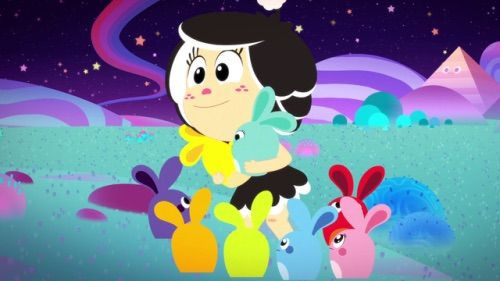
This was a sleeper hit tbh. The fact all the episodes were free on Youtube blew my mind, but having a well structured story with a lovely cold space color palette, actually relatable characters, and a sinister undertones below its tender, colorful charm to be as a nice headliner to when Friendship is Magic came back in spring. It was an inviting start for the year, and with the guy behind Motorcity and Superjail taking the helm and having two more seasons being produced, Hanazuki is something I find is in good hands come 2018.
9. LITTLE WITCH ACADEMIA
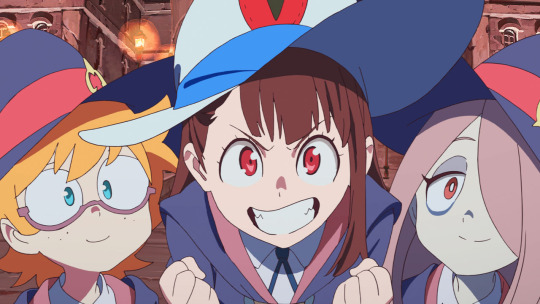
Four long years. I waited FOUR long goddamn years...and fuck me was it worth it. A spectacle is what I can call Little Witch Academia. Almost every episode dazzled me with its stage made bravado and confidence that always made me say, “Okay. Let’s make it til’ the next week”. Even when things got serious, LWA knew how to have fun and make the most of its concept. There is a sense of predictability sometimes, but the series would still throw you some good curve balls to never lose your interest. What did lose my interest was Netflix’s sorry excuse of a dub. The movies: fine. But Netflix, try that again, with any other anime, and I will rip your nuts off.
8. Now I might be cheating here since it’s not a cartoon, but shit it might as well have been
CUPHEAD
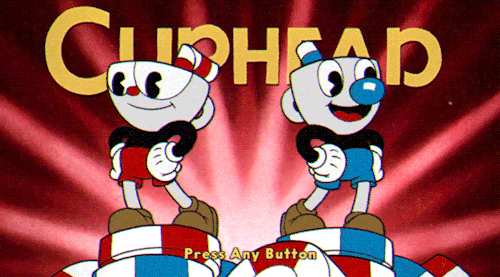
The effort that went into this is phenomenal, beyond the many other games of the year no doubt. While not everything is animated, I could tell they were cutting corners in some areas, the frame BY frame animated enemies, bosses, and effects made this one of the most visually colorful and alive games to date, next to Mario Odyssey. Not only was this game a frustrating yet joyous romp to start and finish, but the music and art flawlessly channeled the essence of a time where the word “cartoon” was only starting to make good progress. My favorite character would have to be Satan King Dice, whom is an animated homage to great musician and composer Cab Calloway. His stache, his clothing, even his Cheshire grin captured the cool, jazzy vibe Calloway always provided in his performances. He and his fight was the highlight of Cuphead for me and I hope this game, if a sequel isn’t possible, is well remembered for its unexpected excellence in how a video game can look.
7. CAPTAIN UNDERPANTS/L-EGGO BATMAN
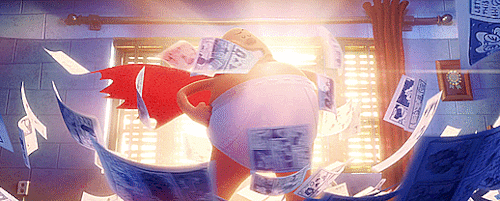
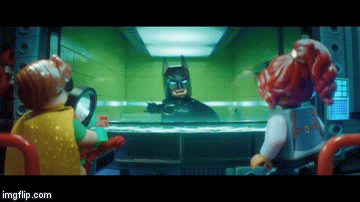
Faithful is what I can describe these two. Captain Underpants was just an awesome book to elementary schooler me, but to see a well animated, well written movie about a dude in his underwear was nothing short of a simple yet powerful masterpiece. As for Batman, this is one of the three truest DC and Batman movies around this time, and it has a gay undertone with Batman and the Joker’s relationship (how can you not pull that off, Suicide Squad?). While not a big fan of lego myself, The Lego Movie put my faith WB making another one equally as good, and they did not disappoint. It’s a shame it got snubbed at the Golden Globes, it deserves the award more than the Boss Baby. Plus it had a Superman that didn’t bore me while having a terrible CGI lip job that’s only made worse by his two way dick nose....
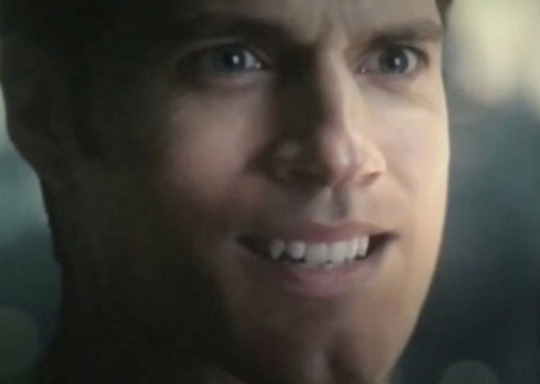
Justice League costed 300,000,000 dollars.............
6. DANGER & EGGS
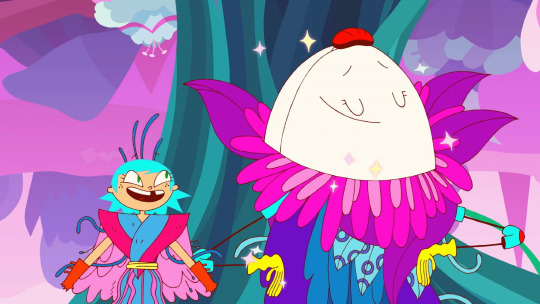
To me, this series felt like one of the few steps forward the world took to make the LGBT+ community feel more welcome and inspired in public outlets; a small step, but progressive none the less. It is a colorful and lively action comedy, a first to be created by a transgender person, where you can see a non-binary character, a pride fest, diverse background characters of orientation and ethnicity, and it feels like they are a part of the world and not footnotes that states that you should respect queer, bi, ace, and so on based on a say so. It’s a show don’t tell type of series and it brightened my summer before I had to remind myself that college exists and is expecting me.
5. TANGLED: THE SERIES
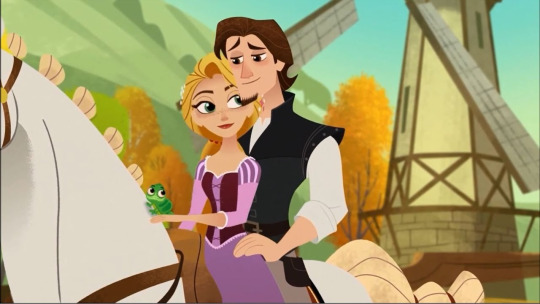
*ring ring* “Hello?” Ye, Disney? How fucking dare you?
My hype for this was undoubtful. I love Tangled the movie, I consider it one of my favorite 2010 disney flics beside Wreck it Ralph and Moana. And when the art style was up for a preview for this (?), I just sat and waited until it finally premiered and damn. I never stopped loving it, but it is until episode 16 where the series starts to hit high note after high note with the direction it’s going for the story. The fact that this all takes place not long after the movie makes the thought where Eugene and Rapunzel finally get married feels all the more earned. It’s working its way to a happily ever after, I adore this show, and this makes me appreciate Frozen a bit more for how far that’s fallen in the world after its one year of fame. Seriously, Gigantic had to get chopped, but Olaf can still live? Give me a break, Disney.
“Sir, I understand your enthusiasm....but this is Domino’s.” Then I will have the 5.99 large with Salchicha and pepperoncini with a liter sprite on delivery.
4. MADE IN ABYSS
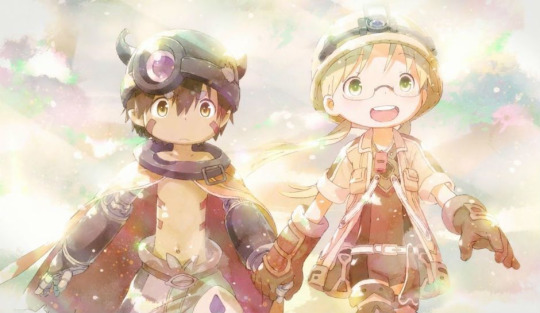
This was so beautiful, so awesome, and much better than...
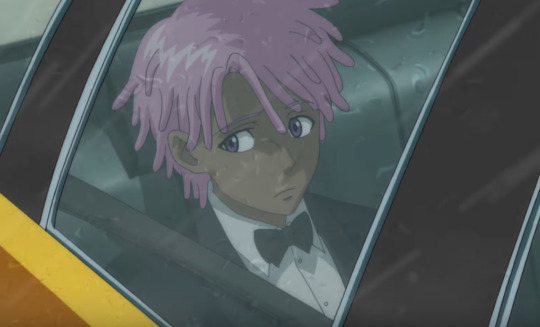
I wasted my life and I cannot say that I will ever reclaim that time proactively again the Anime
Made in Abyss is like Hunter x Hunter except Gon’s more booksmart and Kilua’s a timid robot. The bond between Riko and Reg was a fucking dynamic and heartfelt where Riko’s helps build Reg up and Reg kept Riko and himself safe with his bodily arsenal. That and this series has the best world building where they not only give the low down on almost everything about the titular abyss, but the atmospheric environments and the designs of the inhabiting creatures made this a unique world to want to explore myself. It knew what to show, and knew what to share. When things got serious, I actually tensed up at the thought of shit truly going down; they knew how to soften the terror while maniacally instill fear in us for the safety of the traveling kids. I want to recommend this link to an awesome breakdown of how great Made in Abyss was. However, as it seems that a season two has gone down the abyss as well, and I’m afraid it can’t come back up.
3. LET’S BE HEROES!!
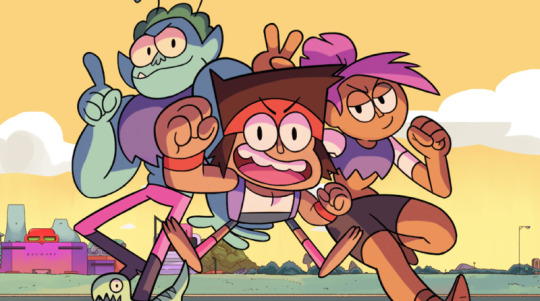
Is it safe to call this the M.U.G.E.N. of cartoons? Just an all up mashup of stuff I love in a Saturday morning? Campy, action, and laid back, this is something I can be sober or grab some kush and I would be enjoy the show just the same. They even have references you might not have ever heard of, but might like the search. OK KO’s a popcorn cartoon, it’s not for everybody, but it established itself well into the modern CN era when Adventure Time finally has to move on.
2. SAMURAI JACK
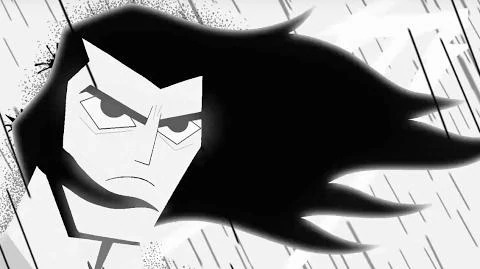
Getting this out of the way: episode 6 toiled the final season of Samurai Jack for me. Not gonna go into detail, but if that episode was remade, I would have been more satisfied looking back. However, that does not stop me from saying this is how a revival should be, this is how a reboot should work, THIS is how you can bring nostalgia back. Samurai Jack was great back then, but this season, wrapping up the loose plight of our boy trying to get back to the past and defeat the demon Aku, was satisfactory to many fans. Even those who’ve never heard or remember Jack could just enjoy this as a dynamic mini-series; it gives you context of what happened before without having to recap the original plot of it. For non fans, it’s mostly about an ageless samurai, longing to return to his own time, stuck in the future for over 50 years to the point of losing his honor and his mind. It’s a binge worthy 10 episode season, originally intended to be a movie, and aside from polar opinionated finale, this made Samurai Jack feel great to love again.
1. TRUE AND THE RAINBOW KINGDOM
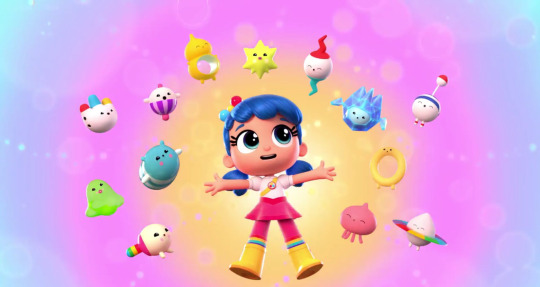
This is a personal choice from me because 2017 was an honest to god terrible year for me; nothing but turmoil, season to season, and the struggle to cope with that despair in a way I felt actually could help. However, this small series here boosted my spirits because even with it being a show for little kids that I originally wanted to watch as a joke, the competent, enthusiastic spirit it had just moved me in a way that cartoons that I love for eons could only try to do on a whim. It’s not the best made cartoon, it’s not something I sincerely recommend to you all, but it helped me realize that the best thing about life is finding and seeking things that don’t just distract you from the hard and testing times reality puts on you, but gives you a moment of honest bliss and happiness that can influence your outlook on looking forward to better things because things like this, cartoons like this, CAN make you feel better.
*sniff* Which is why, the actual cartoon of the year....
1. is STEVEN U., BABY!
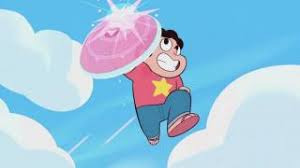
Just kidding, guys! You will NEVER win, Steven!

TEEN TITANS GO! WINS IT AGAIN, BABYYYY! ONCE AGAIN BABY (i don’t even like it no more...), YOUR NEW FAVORITE SHOW (i don’t even fucking like it no...) RISES TO THE TO-
But Steven Universe in Space, though. That’s when it’ll be great again.
#best of 2017#cartoons#anime#animation#Good Stuff#cartoon network#reviews#long post#ok ko#Samurai jack#Hanazuki#Little witch academia#danger & eggs#tangled the series#captain underpants#Lego batman#Cuphead#Made in abyss#true and the rainbow kingdom#TTG#SU#Roy Macintosh#awesome#ye
783 notes
·
View notes
Text
5 BEST XBOX ONE GAMES EVER
The rundown of the best Xbox One games is an intriguing spot to be, particularly as we sit on the cusp of the people to come. These are the titles that truly flaunt the comfort at its best, pushing the limits of what’s fit, and therefore the subsequent rundown of games is a great thing, even with Xbox Series X and the related forthcoming Xbox Series X games not too far off.
So whether you’ve quite recently gotten tied up with the Xbox family through a Xbox One S group or Xbox One X deal (or you’re searching for your next clump of Achievements to pursue), these games are ensured to intrigue. Right away, how about we get into our picks for the best Xbox One games, which we’ll continue updating as new releases demonstrate they merit a spot on the rundown. Goodness, and make certain to look at our modest Xbox game deals page on the off chance that you see anything you like here – we’re generally watching out for deals concerning the greatest and best Xbox One games.
1. The Witcher 3: Wild Hunt

One of the most interesting RPGs ever released – a champion, alterable story line, interminably fulfilling detective cum-assassin Contracts, and side missions more profound than numerous games’ principle campaigns. The Witcher 3’s world is one of the few game spaces to deserve that title – loaded with political interest, old stories and gross beast to cut into ribbons. And the entirety of that is neglecting to make reference to CD Projekt RED’s raft of free DLC, and a few extension packs – the first, Hearts of Stone, is answerable for this shooting up to the most elevated ranges of this rundown. Wonderful, fulfilling and fundamental, this is a game we’ll recollect for a considerable length of time and years to come.
2. Red Dead Redemption

Red Dead Redemption 2 may be delayed to start and is the original ‘it gets great 20 hours in’ sort of game, yet when we mean great, we mean great. Its expansive Wild West opera works out a universe of characters in a changing time and take you on an adventure with them as they face the new world dominating while at the same time battling the former one despite everything pursuing them down. Arthur Morgan is a gruff, hero full of depth, fit for growing a mean facial hair, and with bounty to keep him occupied. This is game where you can loot a bank, chase creatures, fish, play a game of cards, and meet various outsiders with lots for you to do. While there’s a story to follow, with probably the best highs and lows in gaming, there’s additionally only an enormous, living spot to possess and live in. Clear your schedules since this a game that has you in for the long stretch.
3. Fallout 4

We kind of realized what we were getting. It’s large, it’s buggy, it’s Bethesda. Fallout 4 is a characteristic advancement, carrying with it the regularly careless investigation, delicate silliness and moral greyitude of the last two portions, while propping everything up with another gen veneer. They probably won’t be colossal shifts, however primary character voice acting, better gunplay and (stun) not peering inside crates to rob them all make this a smoothed out adaptation of a now-great formula. Frame rate plunges and once in a while frightening glitches back their heads of course, however it’s hard to feel really awful when there’s just such a great amount going on. By and by, Bethesda has packed a few games of happily unimportant stuff in here, bringing about one of the most habitual, moreish games of this age. Stall out in, and you won’t develop for a considerable length of time.
4. Metal Gear Solid 5: The Phantom Pain

In the event that we didn’t know better (or should that be worse?), we’d state Konami removed the Hideo Kojima brand from his last stab at MGS 5: The Phantom Pain since it feels so extraordinary to his past endeavors. Truly, it’s pressed with the messed up jokes, mechanical resourcefulness and fear inspired notions so wild they’re apparently drawn from the darkest of the web depths – however at its core, this is an altogether different sort of Hideo Kojima game.
The change to all the open spaces including numerous missions not just makes this a humiliating masterclass for the remainder of the world stealth-action developers, yet successfully transforms each player into their own spy film director. That time you pulled off a strained, magical heist nearby your quiet expert sniper pal? That was all you. When everything went tits up and you had to explode C4 stashed over an adversary base, before riding into the nightfall on your very own chicken-mech? You were the draftsman. It’s for quite some time been said that Hideo Kojima has been more obsessed with imitating his preferred movies than making true games. MGS 5 demonstrates that to be wrong – he needs you to do that without anyone else’s help. We’ll joyfully put in two or three hundred additional hours obliging him.
5. Apex Legends

Respawn Entertainment’s fight with royale came out of completely no place and quickly overwhelmed the world. Apex Legends joins the best bits of Overwatch onto the recognizable where-we-droppin’ formula of Fortnite, with default crews of three Legend characters who use remarkable capacities that let you perfect your role. Likewise with Respawn’s Titanfall series, the first individual shooting is superb, with a wide assortment of weapons that reward authority (indeed, even the scandalously underpowered Mozambique has its own time) and feel incredible to shoot. Like Fortnite, Apex Legends is allowed to play with cosmetic microtransactions, so anybody and everybody can drop in and check whether they have the stuff to turn into a Champion.
5 BEST XBOX ONE GAME EVER
The rundown of the best Xbox One games is an intriguing spot to be, particularly as we sit on the cusp of the people to come. These are the titles that truly flaunt the comfort at its best, pushing the limits of what’s fit, and therefore the subsequent rundown of games is a great thing, even with Xbox Series X and the related forthcoming Xbox Series X games not too far off.
So whether you’ve quite recently gotten tied up with the Xbox family through a Xbox One S group or Xbox One X deal (or you’re searching for your next clump of Achievements to pursue), these games are ensured to intrigue. Right away, how about we get into our picks for the best Xbox One games, which we’ll continue updating as new releases demonstrate they merit a spot on the rundown. Goodness, and make certain to look at our modest Xbox game deals page on the off chance that you see anything you like here – we’re generally watching out for deals concerning the greatest and best Xbox One games.
1. The Witcher 3: Wild Hunt

One of the most interesting RPGs ever released – a champion, alterable story line, interminably fulfilling detective cum-assassin Contracts, and side missions more profound than numerous games’ principle campaigns. The Witcher 3’s world is one of the few game spaces to deserve that title – loaded with political interest, old stories and gross beast to cut into ribbons. And the entirety of that is neglecting to make reference to CD Projekt RED’s raft of free DLC, and a few extension packs – the first, Hearts of Stone, is answerable for this shooting up to the most elevated ranges of this rundown. Wonderful, fulfilling and fundamental, this is a game we’ll recollect for a considerable length of time and years to come.
2. Red Dead Redemption

Red Dead Redemption 2 may be delayed to start and is the original ‘it gets great 20 hours in’ sort of game, yet when we mean great, we mean great. Its expansive Wild West opera works out a universe of characters in a changing time and take you on an adventure with them as they face the new world dominating while at the same time battling the former one despite everything pursuing them down. Arthur Morgan is a gruff, hero full of depth, fit for growing a mean facial hair, and with bounty to keep him occupied. This is game where you can loot a bank, chase creatures, fish, play a game of cards, and meet various outsiders with lots for you to do. While there’s a story to follow, with probably the best highs and lows in gaming, there’s additionally only an enormous, living spot to possess and live in. Clear your schedules since this a game that has you in for the long stretch.
3. Fallout 4

We kind of realized what we were getting. It’s large, it’s buggy, it’s Bethesda. Fallout 4 is a characteristic advancement, carrying with it the regularly careless investigation, delicate silliness and moral greyitude of the last two portions, while propping everything up with another gen veneer. They probably won’t be colossal shifts, however primary character voice acting, better gunplay and (stun) not peering inside crates to rob them all make this a smoothed out adaptation of a now-great formula. Frame rate plunges and once in a while frightening glitches back their heads of course, however it’s hard to feel really awful when there’s just such a great amount going on. By and by, Bethesda has packed a few games of happily unimportant stuff in here, bringing about one of the most habitual, moreish games of this age. Stall out in, and you won’t develop for a considerable length of time.
4. Metal Gear Solid 5: The Phantom Pain

In the event that we didn’t know better (or should that be worse?), we’d state Konami removed the Hideo Kojima brand from his last stab at MGS 5: The Phantom Pain since it feels so extraordinary to his past endeavors. Truly, it’s pressed with the messed up jokes, mechanical resourcefulness and fear inspired notions so wild they’re apparently drawn from the darkest of the web depths – however at its core, this is an altogether different sort of Hideo Kojima game.
The change to all the open spaces including numerous missions not just makes this a humiliating masterclass for the remainder of the world stealth-action developers, yet successfully transforms each player into their own spy film director. That time you pulled off a strained, magical heist nearby your quiet expert sniper pal? That was all you. When everything went tits up and you had to explode C4 stashed over an adversary base, before riding into the nightfall on your very own chicken-mech? You were the draftsman. It’s for quite some time been said that Hideo Kojima has been more obsessed with imitating his preferred movies than making true games. MGS 5 demonstrates that to be wrong – he needs you to do that without anyone else’s help. We’ll joyfully put in two or three hundred additional hours obliging him.
5. Apex Legends

Respawn Entertainment’s fight with royale came out of completely no place and quickly overwhelmed the world. Apex Legends joins the best bits of Overwatch onto the recognizable where-we-droppin’ formula of Fortnite, with default crews of three Legend characters who use remarkable capacities that let you perfect your role. Likewise with Respawn’s Titanfall series, the first individual shooting is superb, with a wide assortment of weapons that reward authority (indeed, even the scandalously underpowered Mozambique has its own time) and feel incredible to shoot. Like Fortnite, Apex Legends is allowed to play with cosmetic microtransactions, so anybody and everybody can drop in and check whether they have the stuff to turn into a Champion.
Respawn Entertainment’s fight with royale came out of completely no place and quickly overwhelmed the world. Apex Legends joins the best bits of Overwatch onto the recognizable where-we-droppin’ formula of Fortnite, with default crews of three Legend characters who use remarkable capacities that let you perfect your role. Likewise with Respawn’s Titanfall series, the first individual shooting is superb, with a wide assortment of weapons that reward authority (indeed, even the scandalously underpowered Mozambique has its own time) and feel incredible to shoot. Like Fortnite, Apex Legends is allowed to play with cosmetic microtransactions, so anybody and everybody can drop in and check whether they have the stuff to turn into a Champion.
5 BEST XBOX ONE GAME EVER
The rundown of the best Xbox One games is an intriguing spot to be, particularly as we sit on the cusp of the people to come. These are the titles that truly flaunt the comfort at its best, pushing the limits of what’s fit, and therefore the subsequent rundown of games is a great thing, even with Xbox Series X and the related forthcoming Xbox Series X games not too far off.
So whether you’ve quite recently gotten tied up with the Xbox family through a Xbox One S group or Xbox One X deal (or you’re searching for your next clump of Achievements to pursue), these games are ensured to intrigue. Right away, how about we get into our picks for the best Xbox One games, which we’ll continue updating as new releases demonstrate they merit a spot on the rundown. Goodness, and make certain to look at our modest Xbox game deals page on the off chance that you see anything you like here – we’re generally watching out for deals concerning the greatest and best Xbox One games.
1. The Witcher 3: Wild Hunt

One of the most interesting RPGs ever released – a champion, alterable story line, interminably fulfilling detective cum-assassin Contracts, and side missions more profound than numerous games’ principle campaigns. The Witcher 3’s world is one of the few game spaces to deserve that title – loaded with political interest, old stories and gross beast to cut into ribbons. And the entirety of that is neglecting to make reference to CD Projekt RED’s raft of free DLC, and a few extension packs – the first, Hearts of Stone, is answerable for this shooting up to the most elevated ranges of this rundown. Wonderful, fulfilling and fundamental, this is a game we’ll recollect for a considerable length of time and years to come.
2. Red Dead Redemption

Red Dead Redemption 2 may be delayed to start and is the original ‘it gets great 20 hours in’ sort of game, yet when we mean great, we mean great. Its expansive Wild West opera works out a universe of characters in a changing time and take you on an adventure with them as they face the new world dominating while at the same time battling the former one despite everything pursuing them down. Arthur Morgan is a gruff, hero full of depth, fit for growing a mean facial hair, and with bounty to keep him occupied. This is game where you can loot a bank, chase creatures, fish, play a game of cards, and meet various outsiders with lots for you to do. While there’s a story to follow, with probably the best highs and lows in gaming, there’s additionally only an enormous, living spot to possess and live in. Clear your schedules since this a game that has you in for the long stretch.
3. Fallout 4

We kind of realized what we were getting. It’s large, it’s buggy, it’s Bethesda. Fallout 4 is a characteristic advancement, carrying with it the regularly careless investigation, delicate silliness and moral greyitude of the last two portions, while propping everything up with another gen veneer. They probably won’t be colossal shifts, however primary character voice acting, better gunplay and (stun) not peering inside crates to rob them all make this a smoothed out adaptation of a now-great formula. Frame rate plunges and once in a while frightening glitches back their heads of course, however it’s hard to feel really awful when there’s just such a great amount going on. By and by, Bethesda has packed a few games of happily unimportant stuff in here, bringing about one of the most habitual, moreish games of this age. Stall out in, and you won’t develop for a considerable length of time.
4. Metal Gear Solid 5: The Phantom Pain

In the event that we didn’t know better (or should that be worse?), we’d state Konami removed the Hideo Kojima brand from his last stab at MGS 5: The Phantom Pain since it feels so extraordinary to his past endeavors. Truly, it’s pressed with the messed up jokes, mechanical resourcefulness and fear inspired notions so wild they’re apparently drawn from the darkest of the web depths – however at its core, this is an altogether different sort of Hideo Kojima game.
The change to all the open spaces including numerous missions not just makes this a humiliating masterclass for the remainder of the world stealth-action developers, yet successfully transforms each player into their own spy film director. That time you pulled off a strained, magical heist nearby your quiet expert sniper pal? That was all you. When everything went tits up and you had to explode C4 stashed over an adversary base, before riding into the nightfall on your very own chicken-mech? You were the draftsman. It’s for quite some time been said that Hideo Kojima has been more obsessed with imitating his preferred movies than making true games. MGS 5 demonstrates that to be wrong – he needs you to do that without anyone else’s help. We’ll joyfully put in two or three hundred additional hours obliging him.
5. Apex Legends

Respawn Entertainment’s fight with royale came out of completely no place and quickly overwhelmed the world. Apex Legends joins the best bits of Overwatch onto the recognizable where-we-droppin’ formula of Fortnite, with default crews of three Legend characters who use remarkable capacities that let you perfect your role. Likewise with Respawn’s Titanfall series, the first individual shooting is superb, with a wide assortment of weapons that reward authority (indeed, even the scandalously underpowered Mozambique has its own time) and feel incredible to shoot. Like Fortnite, Apex Legends is allowed to play with cosmetic microtransactions, so anybody and everybody can drop in and check whether they have the stuff to turn into a Champion.
Respawn Entertainment’s fight with royale came out of completely no place and quickly overwhelmed the world. Apex Legends joins the best bits of Overwatch onto the recognizable where-we-droppin’ formula of Fortnite, with default crews of three Legend characters who use remarkable capacities that let you perfect your role. Likewise with Respawn’s Titanfall series, the first individual shooting is superb, with a wide assortment of weapons that reward authority (indeed, even the scandalously underpowered Mozambique has its own time) and feel incredible to shoot. Like Fortnite, Apex Legends is allowed to play with cosmetic microtransactions, so anybody and everybody can drop in and check whether they have the stuff to turn into a Champion.
The post 5 BEST XBOX ONE GAMES EVER appeared first on PureSourceCode.
from WordPress https://www.puresourcecode.com/news/microsoft/5-best-xbox-one-games-ever/
0 notes
Note
Could you possibly recap the timeline of events in 1980? Specifically I'm interested in when John's Playboy interview was conducted, the publishing of said interview, the recording of Double Fantasy and that album's release. In Paul's Nov interview on GMA he's asked about John's "resentful" Playboy comments. But John then seems to speak fondly of Paul from that point until his death. ? Also there's the rumor that Paul and John were attempting to meet in NY. It's very confusing. Help? THANKS!
Hmm, this is multi-tiered, so first off, here’s a very rough timeline I’ve cobbled together on the fly, focusing mainly on John’s press activities in the latter half of 1980:
August: Barbara Graustark (along with Vic Garbarini) conducts Newsweek interview with John for September 29th 1980 issue.
August 2nd-4th: John and Yoko conduct rehearsals with session musicians at the Dakota for imminent Double Fantasy album recording sessions.
August 6th/7th: John and Yoko enter the Hit Factory studio to start recording the Double Fantasy album.
August 13th: News of John and Yoko recording a new album starts to circulate.
Late-End August: David Sheff flies to New York for Playboy interview with John and Yoko.
September 8th-28th: David Sheff conducts Playboy interview with John and Yoko for January 1981 issue.
September 22nd?: September 29th 1980 issue of Newsweek hits newsstands.
September 24th/29th: Lisa Robinson conducts interview with John.
October 10th: Robert Hilburn conducts interview with John.
October 13th: Recording, overdubbing, and mixing for the Double Fantasy album is completed.
November 17th: The Double Fantasy album is released worldwide.
November 27th: David Hartman conducts interview live via satellite with Paul and Linda on Good Morning America.
December 5th: Jonathan Cott conducts Rolling Stone interview with John for January 22nd 1981 issue.
December 5th/6th: January 1981 issue of Playboy hits the newsstands.
December 6th: Andy Peebles conducts BBC radio interview with John and Yoko.
December 8th: Dave Sholin conducts RKO radio interview with John and Yoko.
December 8th: John is killed.
The relevant excerpt from Paul’s Good Morning America interview:
HARTMAN: Paul, there’s a new interview out that John – you mentioned John a while ago – and he talks very openly. Without going into details, he seems to have a lot of resentment, competition, with you. And he says you kind of died creatively in a way, and he didn’t keep track of you, he said ‘The Long And Winding Road’ was your last gasp… How – he seems resentful of you. Do you know why, or—?
PAUL: [uncomfortable] Um… I don’t know, I can guess and stuff, you know, but I’ll tell you, after all of that stuff has sort of gone down over the years, I actually keep a bit quiet now, ’cause anything I say, he gets resentful of. So I don’t know really, I mean, uh… it’s just a weird one. I don’t quite know why he thinks like that. I mean, what do you do about that? I – I really just shut up these days. I think it’s the best policy, David.
And the relevant excerpts from John’s Playboy interview as published in the magazine’s January 1981 issue (and as quoted by Hartman above):
PLAYBOY: What about the music?
JOHN: ‘The Long and Winding Road’ was the last gasp from him. Although I really haven’t listened.
…
PLAYBOY: Just a quick aside, but while we’re on the subject of lyrics and your resentment of Paul, what made you write ‘How Do You Sleep?,’ which contains lyrics such as ‘Those freaks was right when they said you was dead’ and ‘The only thing you done was Yesterday/And since you’ve gone, you’re just Another Day’?
JOHN: (smiles) You know, I wasn’t really feeling that vicious at the time. But I was using my resentment toward Paul to create a song, let’s put it that way. He saw that it pointedly refers to him, and people kept hounding him about it. But, you know, there were a few digs on his album before mine. He’s so obscure other people didn’t notice them, but I heard them. I thought, Well, I’m not obscure, I just get right down to the nitty-gritty. So he’d done it his way and I did it mine. But as to the line you quoted, yeah, I think Paul died creatively, in a way.
(It goes without saying that the magazine version differs from the book and original interview recordings, but as it’s not pertinent to your questions, there’s no need to go into it here. In any case, listen to the audio clip for the “last gasp” quote here.) And now to address your queries!
1. In Paul’s Nov interview on GMA he’s asked about John’s “resentful” Playboy comments. So, as indicated by the timeline above, and unless I’m hideously misinformed, Playboy only hit the newsstands in early December, after Paul’s Good Morning America interview. I can only presume from this that excerpts from the interview, if not the print interview in full, were released to the press prior to the magazine hitting newsstands, which is fairly common practice. Hartman didn’t seem like he knew any more than what was in his notes, so I’m guessing that these were the selected pull quotes prepared by the show for Paul to comment on.
2. But John then seems to speak fondly of Paul from that point until his death. ? He was altogether capable of speaking both good and ill of Paul in the decade between the Beatles’ breakup and his death, and did so with impunity. You would do well to take into consideration John’s conduct in the average interview; for all that he was effortlessly adept at putting on the style and creating an illusion of intimacy and candour as the circumstances called for it, he also allowed himself to be led by his own mercurial moods and emotionally-coloured contrariness. His sentiments could vacillate wildly between answers, let alone interviews, and the Playboy interview was conducted over three weeks, which would have given David Sheff more than enough time to witness the many colours and shifting shades of John’s whirling dervish of preoccupations and motivations, his intentions and issues, all alive and undulating and susceptible to fits of unreason even in a body of new sober maturity. In regards to Paul, he was just as likely to recall an arguably spurious and emotionally distorted memory as he was to give voice to a covertly-kept hurt in paranoia wrapping paper as he was to hotly defend Paul’s acumen as a musician as he was to lie boldly about not following Paul’s music as he was to reminisce about the romance of his first trip to Paris. (And that’s just the Playboy interview.) And then there’s all that he wouldn’t or couldn’t say in an interview.
I don’t think I’ll be able to go through the specific significant instances throughout the Playboy interview which exemplify John’s entwined and deeply-rooted feelings towards Paul without dangerously bloating this already convoluted reply, but in the timeline above I’ve linked accordingly to quotes and clips from the various interviews John did in 1980 for you to peruse at your leisure. You’ll find ample examples of fondness and proud exclusivity and keen comparatives and all else in between.
But the love was there, and the love is what’s crucial, and what remains. That is what I’d like to think, at least.
3. Also there’s the rumor that Paul and John were attempting to meet in NY. Ah, I assume you’re referring to the whispers that John and Paul wanted to write together again; I doubt it would have been as pregnant with significance for Paul to just drop by the Dakota as he’d done several times before. Jack Douglas, the producer of Double Fantasy, has attested to John’s intentions to meet up and write songs with Paul again, and the BBC broadcaster Richard Skinner has also attested to Paul’s intentions to meet up and write songs with John again. I vaguely recall at least one other, not terribly reputable source supporting Douglas’ account that Yoko wasn’t allowing Paul’s calls (or anyone else’s, for that matter) to get through to John, but no names or titles are coming to me at the moment, I’m afraid.
And just because I’d like to end off this ask with some entirely irrelevant, palate-cleansing levity: in a absurd and delightful confluence of a few of my favourite things, here’s Hideo Kojima conceiving to stow Will Graham away on a yellow submarine. Amongst other things.
136 notes
·
View notes
Text
Metal Gear Survive Is the Rebirth and Death of Metal Gear
Metal Gear Solid V: The Phantom Pain, the last Metal Gear game helmed by series creator Hideo Kojima, begins with the destruction of a military base. This building, an off-shore platform designed as the home for a mercenary army, falls into fire and rubble, collapsing into the ocean as enemy guns and bombs tear it asunder. The destruction nearly kills Big Boss, the villain-protagonist of the game, putting him in a coma for years. When he awakens, he concerns himself with rebuilding, and revenge.
Metal Gear Solid V is the story of that quest, but it also tells the story of its own storied creation. Much of this tale isn't known, but the gaming press has scraped it together from the aftermath: at some point during Metal Gear Solid V's development, Konami, its publisher, changed directions, moving toward mobile games and Japanese gambling machines as a quicker, easier way to turn its franchises into profitability. It began to segway away from traditional major game development, putting a wedge between Konami and Kojima Productions, its former flagship studio. After Metal Gear Solid V: The Phantom Pain shipped in 2015, Hideo Kojima left Konami, taking an unknown number of Kojima Productions staff with him to start an independent company. Metal Gear, like Big Boss's Mother Base, had fallen apart.
Related Stories
Chris Kohler
Metal Gear Solid 4 and the Marriage of Movies and Games
Chris Kohler
Hands-On: Just a Slice of Metal Gear Rising: Revengeance
Jason Schreier
Kojima Productions Recruiting for Next Metal Gear Solid
That was nearly three years ago. Last year, Konami unveiled the future for Metal Gear—for Konami's big-budget game development, for the Fox Engine software once built by Kojima's team to safeguard the future of the saga, and of Kojima's work itself. That future was Metal Gear Survive, an unlikely spin-off taking place in an alternate reality overrun by uncanny monsters and hidden ruins. It takes one of the most storied, most strange franchises in the history of the medium, and it turns it into a zombie game.
If Metal Gear Solid V is about destruction and revenge, Metal Gear Survive, built out of re-contextualized art assets and design ideas from its immediate predecessor, is about the wreckage: the wreckage left behind by the end of the Konami/Kojima Productions relationship, and the wreckage of Metal Gear Solid V itself.
Metal Gear Survive begins precisely where Metal Gear Solid V: The Phantom Pain does: with the destruction of Mother Base. Even using some of the same footage, it details the carnage that led to the death of Big Boss' mercenary army and the massive industrial structure that housed it. But where The Phantom Pain follows Big Boss, Survive's first and perhaps most interesting gesture is to focus instead on the soldiers under his command. In a bizarre twist, some of these soldiers, along with some of Mother Base itself, are pulled through an interdimensional wormhole into the wasteland world of Dite (the Dante's Inferno reference is both intentional and thoroughly overexplained, in true Metal Gear fashion), whose inhabitants have been turned into monsters by some unknown, crystalline parasite.
This gesture, in the form of an out-there weird science plot twist, is also the first sign that this is Metal Gear minus much of the creative talent that formerly powered it. Metal Gear under Kojima Productions always had a balance of mundane and magic, military paranoia and freakish science fiction, but the balance has never been as tipped in one direction as it is here. Whereas Metal Gear is often silly, Survive immediately turns cheesy, and rarely stops. Judging by writing alone, Survive could rank as the most expensive direct-to-DVD sequel in history.
Whereas Metal Gear is often silly, Survive immediately turns cheesy, and rarely stops.
But, in a move that would have been unheard of in traditional Metal Gear, the writing of Survive is secondary to the experience of its world. Dite is a strange place. Even ignoring the unfortunate political implications of labelling re-used environmental designs, originally meant to represent Afghanistan and Angola as a "wasteland," it's a distinctly uncanny locale. A metaphorical purgatory, Dite is marred by fog, ruins, and monsters. Portals occasionally open in the sky, dropping wreckage and refugees. Pieces of Mother Base are strewn about the scenery, gnarled and scorched. Walls of choking dust turn much of the world into a hazy hellscape, forcing you to carry an oxygen tank and move with the utmost care.
As one of Big Boss' refugees, stranded in Dite, your job is to get home. In an inversion of Metal Gear's traditional stealth action, the goals here are simple: find food, build a base, and live long enough to find a way to open a portal out of this awful, mesmerizing place. To do this, you have to make use of all of Metal Gear Solid V's systems, now rearranged and added to in service of survival. You have to sneak, and fight, using your military training and whatever improvised tools you can find. Like in MGSV, you build and defend a base, and that base becomes a home for research, resource gathering, and personnel management. Like in MGSV, you take part in missions dotting the landscape, gaining materials and knowledge to expand your base while unravelling a strange, twisty narrative.
But the shift in focus, from commander to grunt, brings an urgency and depth of insight that's surprising, even if that insight fails to ever broach the written narrative. Big Boss and his ilk were killers, bad men, villains created by circumstance as well as by their own choices. While Kojima's games often align the player's perspective with that of Big Boss, it also criticizes it, and at best Metal Gear Solid V is a tale of gray morality versus black morality. At its worst, it's a tale of monstrous warlords trying to destroy each other, the political stability of the world left to their awful whims. As a soldier left behind by that conflict, you stand in contrast to that struggle in Survive. Big Boss is gone, as are his wars. What's left in Dite is just the aftermath, the casualties that are forgotten about. Dite is a purgatory for wayward soldiers left to die.
Its framing may be derivative, but that seems less a problem here and more of a feature: Metal Gear Survive takes the art and design of its predecessor and attempts to make a complete game out of it.
It's also a purgatory for Metal Gear itself. Playing, it's impossible not to read the wreckage of Mother Base as a metaphor for the franchise. MGSV was a notoriously incomplete game, at least according to fan interpretation. It lacks a satisfying ending, and many of the late-game missions are just old missions repurposed. Much of the care that characterizes the older titles of Kojima Productions seems to be missing, a victim of the game's behind-the-scenes circumstances. In that context, Survive reads like a self-conscious attempt to sift through that wreckage. Its framing may be derivative, but that seems less a problem here and more of a feature: Metal Gear Survive takes the art and design of its predecessor and attempts to make a complete game out of it. As the player sifts through the wreckage of Mother Base and Big Boss's revenge, its design is sifting through Metal Gear, deciding what to keep and what to throw away.
The decisions the developers of Survive make are not always good, and it's clear Konami intends the game at least in part to try to recoup the money and time used to develop the Fox Engine, which was ultimately only used to make two games (Metal Gear Solid V and the aborted Silent Hill teaser PT) before Kojima left the company. It's full of microtransactions and busy work. But it's also full of surprising bursts of excellence, some borrowed from the heights of its predecessor and some wholly new. The monsters, shambling soldiers with precious crystals bursting from their limbs, were designed by Masahiro Ito, who created some of the best creatures in Konami's other orphaned flagship, Silent Hill. As dead soldiers that need to be killed again so they can be literally mined as resources, their design makes explicit ideas about dehumanization and war that Metal Gear Solid V leaves to subtext. The defensive combat, powered by the same design that made MGSV incredible to play, is tense and engaging.
There's a moment around the middle of Metal Gear Solid V that is telling of what Metal Gear Survive is, and what it does. In it, Big Boss, in the wake of another enemy attack, memorializes some of his fallen soldiers. Refusing to empty their ashes into the sea, he declares that he will make diamonds out of them, so that his loyal soldiers can be carried into battle posthumously. Disregarding the silliness of the idea, this moment emerges as both sweet and tragic. Big Boss is trying to honor the sacrifices made in his cause, but he's blinded by the cruelty of his cause. The only thing he has to offer men and women victimized by war is the promise of more war.
Metal Gear Survive is like that. It's a fascinating, sometimes beautiful commentary on the life and death of Metal Gear, made in the absence of the creative minds who guided it for decades. But there's something tragic that, to memorialize the loss of one of gaming's greatest, Konami could think of nothing but to make another Metal Gear.
More WIRED Culture
The inside story of Pong and Nolan Bushnell’s early days at Atari
What does “self-care” mean amid the barrage of news and social media?
The strange history of one of the Internet’s first viral videos
Related Video
Gaming
The Psychology Behind Video Game Sounds (1972-1998)
Four video game sound designers explain the thinking behind some of the world's most recognizable video game sounds. Featuring sounds from Pac-Man, Sonic the Hedgehog, Donkey Kong, Mario Kart, Contra, Street Fighter II, Doom and more!
More From this publisher : HERE ; This post was curated using : TrendingTraffic
=> *********************************************** Read Full Article Here: Metal Gear Survive Is the Rebirth and Death of Metal Gear ************************************ =>
Metal Gear Survive Is the Rebirth and Death of Metal Gear was originally posted by 11 VA Viral News
0 notes
Text
For the last few years, we’ve slowly been fed scraps of information about the new game from Metal Gear legend Hideo Kojima, Death Stranding. And because this is Kojima, most of what we’ve been getting has been delicious, deep-diving and depraved nonsense. So what kind of game will we be playing this November?
A while ago we hear from Kojima-San that the name Death Stranding is derived from suicidal whale behavior. Then, we got a teaser that heavily featured a baby growing in someone’s throat. And finally, we heard word about the cast, which featured everyone from Walking Dead favorite Norman Reedus to The Shape Of Water director Guillermo Del Toro. But what we didn’t get throughout any of this process was a general shape of what the game was actually going to play like. And even after a massive nine-minute trailer… well, we still don’t know what the hell is going on.
Never heard of the “social strand” game genre before? That’s because it has just been deposited by the makers of Death Stranding. A Kojima Productions title which is one of the most anticipated games of this year. A collaboration between Kojima Productions and Guerilla Games in which knowledge is shared and Death Stranding now has the “Decima”engine to put at good use. There’s lots more detail on the Death Stranding release date trailer below, and alongside that all important launch date we also got to see new characters, including American actress and Leftovers star Margaret Qualley as Mama, Drive director Nicolas Winding Refn as Heartman and How To Get Away With Murder’s Tommie Earl Jenkins as Die-Hardman.
#gallery-0-7 { margin: auto; } #gallery-0-7 .gallery-item { float: left; margin-top: 10px; text-align: center; width: 33%; } #gallery-0-7 img { border: 2px solid #cfcfcf; } #gallery-0-7 .gallery-caption { margin-left: 0; } /* see gallery_shortcode() in wp-includes/media.php */
First Gameplay Gimpse
Sam’s role as a courier includes using gadgets like ladders and climbing anchors to explore the world. And besides that he has to avoid enemies chasing him with big electrified spears (why spears but not guns). If you’re wondering why all the plants are dying and one of the men starts rapidly ageing, it’s because of a thing called Timefall – aka rain from another world. “Most people in the game are aware of the rain – and well Sam is quite unique in this regard.”
According to information cribbed from the game’s website, much of what makes Death Stranding unusual is its reduced focus on murder. Apparently, the game will be completeable “almost” bloodlessly. More than that, there’s actually no ‘game over’ title screen in this game. Killed characters wake up in a dreamlike upside-down world, which they’ll have to navigate their way back in order to reach reality. “At that point, you’re not dead or alive. It’s the equivalent of that screen that says ‘Continue?’ and a counter ticking down towards zero,” said Kojima. It seems like Death Standing’s version of death is a bit like Dark Souls. “Death will never pull you out of the game,” added Kojima.
youtube
No One Knows
Not even the actors in Death Stranding know much about the plot details as Norman Reedus once stated. Guillermo Del Toro says: “[Kojima] scanned my body and face for the model over an entire day in Toronto. He needed it for a digital avatar (and for blackmail, perhaps) and then he sent me the teaser you all saw. That’s it. He sends me toys and gifts every few weeks but no clues. I am dying to know.”
Kojima is not spilling his guts but gives us incomplete and vague statements like the following:
‘Death Stranding is a completely new type of action game, where the goal of the player is to reconnect isolated cities and a fragmented society. It is created so that all elements, including the story and gameplay, are bound together by the theme of the “Strand” or connection. As Sam Porter Bridges, you will attempt to bridge the divides in society, and in doing create new bonds or “Strands” with other players around the globe. Through your experience playing the game, I hope you’ll come to understand the true importance of forging connections with others.’
#gallery-0-8 { margin: auto; } #gallery-0-8 .gallery-item { float: left; margin-top: 10px; text-align: center; width: 33%; } #gallery-0-8 img { border: 2px solid #cfcfcf; } #gallery-0-8 .gallery-caption { margin-left: 0; } /* see gallery_shortcode() in wp-includes/media.php */
Theory Limbo
Transhumanism, parallel universes or travelling the fourth dimension. We know nothing for sure as to what the underlying theory of Death Stranding is. Kojima speaks about sticks and ropes a lot which implies the core is about connecting to something or someone. Or is Kojima addressing evolution of some sort. Let’s say evolving into digital consciousnesses or the evolution of internet as we know it. Have avatars like Sam become aware inside this VR world we are controlling/ playing. Or is Kojima giving us a cautionary tale (like in MGS 2 about fake news), telling us not to lose our human connection. Take the gut feeling we have, referred by all the gut-strand scenes we see in the trailers. He even refers to his company logo as Homo Ludens or Man Who Plays .
It might take a while until some Reddit user figures it all out, or it even might take us completing the game in November to be “woke”.
Be sure to keep an eye out for more info in the coming months right here at GameGeekz.eu!
Death Stranding; What is this first Action Strand Game? For the last few years, we’ve slowly been fed scraps of information about the new game from Metal Gear legend Hideo Kojima, Death Stranding.
#Death Stranding#Decima#explained#Guerilla games#Hideo Kojima#Kojima Productions#Ludens#Norman Reedus#playstation#Playstation 4#theory
0 notes
Text
Metagaming: Will the Novelty Ever Wear Off?
I’ve played some amazing games this past year, the best of these being an indie game called “OneShot”. I wanted to explore the idea of metagaming and how this game does it so well.
WARNING: I will be going into explicit detail about “OneShot” and a bit into “Metal Gear Solid.” I put up *SPOILER WARNING*s where I will go into more detail, if you’d like to avoid those, and an *END SPOILERS* when it’s all over (although this will be a very short read if you skip the good stuff). I will include a link to download the game if you are interested in playing it for yourself.
OneShot
“The world knows you exist.”
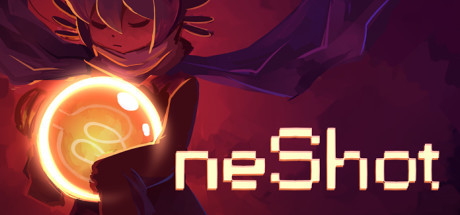
I played this game at the end of 2017 and it left me absolutely speechless, with goosebumps and a lot of feelings for the pancake-loving cat child Niko. The charming pixel art style, the characters, the puzzle mechanics, and the story all had me caring so much.
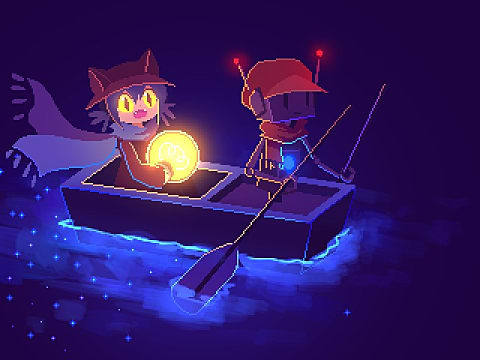
(Look at them. I would die for Niko.)
In this top-down style puzzler, Niko wakes up in an unfamiliar dilapidated house with no idea how they got there. After wandering around and solving a few tutorial puzzles, Nika manages to turn on a computer in the bedroom. The computer tells us that it is our job to guide Niko through this perilous world safely, which should give you pause right away. This computer is talking to you, the player, not Niko, the character. From here, we will be talking major spoilers so if you want to play the game for yourself (and I HIGHLY recommend that you do and I’m not getting paid to say that) it’s available here on Steam.
*SPOILER WARNING*
From the get go, this game has you wondering just how much the game knows about you. The entity in the computer knows your name and can communicate to you through Windows popups. Which scared the living crap out of me when I first started playing. After the initial shock, I started laughing. I knew I was in for a ride.
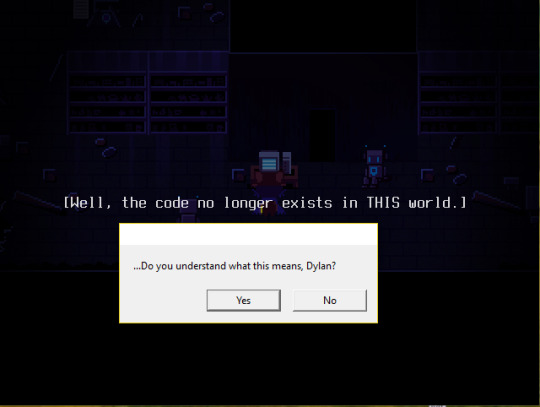
(Screenshot from this review)
You are never asked for your name when you click “Start,” yet the entity knows who you are. I’m still trying to figure out from where exactly they pulled my name. Codes are hidden in your document files. Niko talks to you directly, every character in this crazy world is calling you “God,” and is aware of you leaving when you close the game. It doesn’t take long to realize that this world that Niko is lost in isn’t real. All Niko wants is to go home, but this world (real or not) needs help.
By the end you learn that the game developer, the “Author,” is trying to communicate with you and get you to help save the world they thought was lost. If you choose to smash the “sun” (a giant lightbulb to replace the one that burned out) and save Niko, they walk right out of the game window and back to where they belong. There are very few games that go to these “meta” extremes.
I stumbled across an article while searching for the screenshots used in this post. PC Gamer interviewed developers Eliza Velasquez and Casey Gu about the inspiration for “OneShot.” To my surprise, they cited the Psycho Mantis boss battle from “Metal Gear Solid.” Okay after thinking about it, it’s not really surprising. Hideo Kojima was the first (as far as I am aware) that tried to pull that level of fourth wall breaking all the way back in 1998.
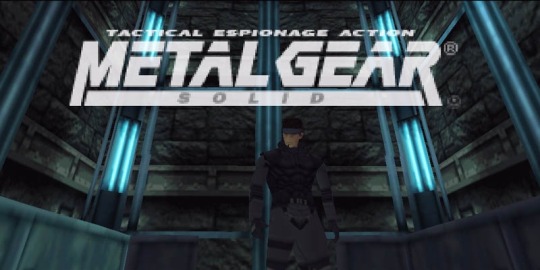
If you’ve never played any of the Metal Gear Solid games (or the original 1987 Metal Gear arcade game), all you really need to know is creator Hideo Kojima is the Tom Clancy of video games. How does he know so much about espionage and military gear? In any case, Metal Gear Solid is a classic series that most avid video gamers are at least aware of. If you are not aware or want to refresh your memory, the entire situation with Psycho Mantis in “Metal Gear Solid” goes like this:
So, you’re about two-thirds of the way through the game, when you finally come across the elusive Psycho Mantis. He’s taken Meryl mentally hostage and is using her against Snake. After you safely knock Meryl out, Psycho Mantis tries more direct methods. The master of psychokinetic and telepathic abilities claims he can read your mind. Yeah, right! You’re not real how could you poss- wait...HOW DID YOU KNOW I’VE BEEN PLAYING CASTLEVANIA AND NOW YOU CAN MOVE MY CONTROLLER WHAT?!? The screen goes black, as if your PS1 has been turned off, only to suddenly come back on. The battle begins and you realize that you can’t get a single hit on this guy. After what feels like hours of fruitless attempts to land a shot, a punch, a kick, ANYTHING on Psycho Mantis, Col. Campbell calls you on the comms and tells you that the solution lies within your PS1 controller ports (back when controllers weren’t wireless); switch your controller from port 1 to port 2 and it will break the mental connection. Well, this is definitely the craziest thing to happen in the game so far, but you’re just going to go for it. And what do you know? It works!
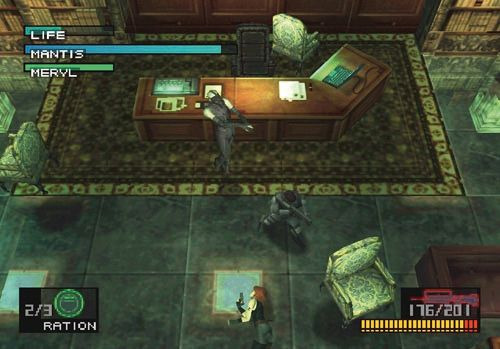
In addition to that, there are several references to the characters Snake and Mei Ling being aware of the save function. I have to talk about this, because it’s one of my favorite exchanges in the game.
“Snake. That's a ladies bathroom.”
“I know that. I saw Meryl come in here.”
"So you went in after her? Are you some kind of pervert? I won't let you save your mission now.”
"Listen Mei Ling, this is the only place on this base that I can talk to Meryl alone.”
"Whatever, weirdo. Don't call me again.”
*END SPOILERS*
There are many more meta aspects of “OneShot” that I could talk about (George the Librarian, the “Solstice” ending, etc.), but I think I’ll leave it here. Video games have clearly come a long way since 1998. Thankfully, because have you seen these graphics? They could program the AI of enemy soldiers to hear a pin drop and be on you in an instant, but they couldn’t program faces?
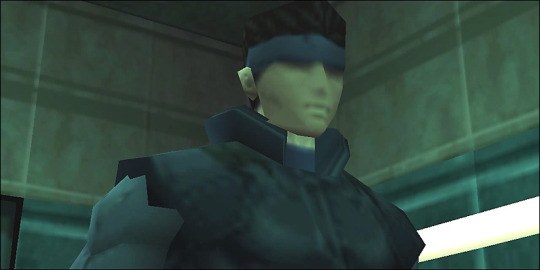
(If you’re supposed to be the “superior” one, then why don’t you have any eyes?!)
Anyway, I’m torn between wanting more games like “OneShot” and not wanting to lose the novelty of games like it. With the recent success of games like “Doki Doki Literature Club” (a game I could write a thesis on but I won’t since it has been talked about to death on Reddit and Tumblr), I think we will see more developers getting into the idea of metagaming. I’m not sure that any of them could create a game that even comes close to making me fall in love with the characters, the story, the puzzle mechanics, and the setting, while leaving me chilled and thinking about it days later. If it is, indeed, possible, then I look forward to the day that game lands on Steam’s New Release page.
0 notes
Text
Why I’m Excited By Jordan Vogt-Roberts and Kong: Skull Island
Things are going well for Jordan Vogt-Roberts. Not only was the Detroit born filmmaker given a 185 million dollar franchise lynchpin in the form of the hugely fun Kong: Skull Island, he seems to have pulled it off, gaining positive reviews (including one from Roberts’ hero Konami’s Hideo Kojima), financial success (it’s the eighth highest grossing film of the year), and firmly launching Roberts into the limelight (he’s been in the news for his attempts to get the job helming the new Metal Gear movie). All well deserved, as Vogt-Roberts has transitioned seamlessly from TV comedies and his coming of age indie The Kings of Summer to the heady heights of a tentpole blockbuster. Here’s some reasons I’m excited to see what’s next. Some spoilers for Kong ahead.
1. He’s from the comedy world
Prior to his movie career, Vogt-Roberts was best known for comedy, stemming from his hilariously melancholic 2010 short Successful Alcoholics. He went on to create and direct Comedy Central’s anarchic stand-up/sketch show Mash Up, as well as helm several episodes of MTV’s overlooked Death Valley and a slew of Funny or Die shorts. This put him in good stead when helming his first feature, giving Kings of Summer an enviable cast of both well established and up-and-coming comedy performers, featuring everyone from Nick Offerman and Alison Brie to cameos from comedy stalwarts lick Craig Cackowski and Tony Hale. A few of these performers were brought over to fill out Kong’s outstanding ensemble cast, with Eugene Cordero and Mark Evan Jackson taking the trip to Skull Island and a blink and you’ll miss it cameo from Silicon Valley’s Thomas Middleditch.
Comedy is clearly integral to his style, as evidenced by the consistent humour peppered throughout Skull Island. As our protagonists make their way through the terrors of the prehistoric island, the subject is nonetheless treated with levity and a sly with, even some character deaths being accompanied with a wry aside. And make sure you look out for the Tim and Eric Awesome Show reference attached to John C. Reilly’s Hank Marlow.
2. He’s a total cinephile
Anyone with a passing knowledge of film can see the clear nods to Coppola’s Apocalypse Now and Kubrick’s Full Metal Jacket in the aesthetic and spirit of Skull Island. But the references go far deeper than Vietnam flicks, the film is full of nods to everything from Cannibal Holocaust to Metal Gear Solid. Who else would have Samuel L. Jackson reiterate his classic line ‘hold on to your butts’?
Japanese culture has a huge purchase on the film, Roberts even stating “The stamp on this movie of video games and anime is massive. That is my childhood. That is my DNA”. He’s also talked about the influences of Miyazaki and Studio Gibhli on the look of the island, the huge variety of primeval flora and fauna that walk amongst and prey upon the rag-tag group of survivors throughout the narrative. “Suddenly Miyazaki and Princess Mononoke and this sense of beauty and spirituality and this slightly heightened mythical feel was created. That broke open the door for the design of what these other creatures should be.” Furthermore, Spirited Away’s ghostly No-Face, amongst other Japanese pop culture icons, had a lot of influence on the film’s villains, the monstrous Skull Crawlers. "That creature, beyond being a reference to a creature from the 1933 film, is also this crazy fusion of all of the influences throughout my life – like the first angel from Evangelion, and No-Face from Spirited Away, and Cubone from Pokémon."
Not only is the film saturated with the director’s own cultural sources, it also pays tribute to its own cinematic forebears. Whilst the story, island, and even Kong himself are markedly different from his iconic first appearance, nods to the 1933 classic appear throughout. From classic images such as the titular ape in chains and his perhaps cathartic revenge in taking down a fleet of helicopters, to the specific reimagining of scenes from the original, such as Kong’s fight with the octopus.
3. He’s not afraid to make bold directing choices
Something that stands out about Kong is just how good it looks. Vogt-Roberts confidently uses bold colours and stylistic imagery to give the film a strong visual style, providing a refreshing change from the often uninspired cinematography seen in other blockbusters, something often lacking in the otherwise consistent Marvel movies (Guardians aside).
These looks and motifs are clearly important to Vogt-Roberts, and Tom Hiddleston later shared this concept art the director shared with him before shooting began.
“In November 2014 @VogtRoberts sent me a frame he wanted to capture in #kongskullisland. Two and a half years later, we brought it to life. pic.twitter.com/zGsn5zXozL”
This decisive and pre-prepared approach to the visuals means the film is full of memorable images, whether it be a young Marlowe standing off with a Japanese pilot on golden beach, the shifting paintings in the native caves, John Ortiz’s doomed head of operations being torn apart in front of a setting sun, or Samuel L. Jackson framed among the flames of the burning lake.
4. He understands the fun in filmmaking
To date, both of Vogt-Robert’s features have been hugely entertaining, with the enthusiastic core of an exceptional ensemble cast. It’s clear that the director likes to nurture a strong bond and camaraderie between cast and crew alike, and his frequently updated instagram account shows that.
Vogt-Roberts, despite his background in indie settings, seems almost built for tent-pole entertainment. His movies are contagiously fun, with a kinetic excitement that in no way undermines the central, beating heart of the movie’s characters and relationships. He puts so much of his heart, soul, and unstoppable devotion into the film that despite it’s schlocky, creature-feature motifs, you can’t help but see his enthusiasm shine through. I for one am excited to see what comes next.
Kong: Skull Island is on home video now.
0 notes